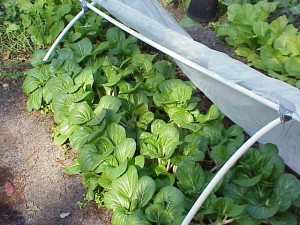Northwest Florida homeowners enjoy growing their own vegetables every fall, but are faced with cold weather issues, especially during the first few days of December. For example, most cole crops can be planted until November, but they must be protected from the cold weather or they will need to be replaced. A good variety of cold tolerant plants should be used in order to prevent total devastation of the garden by extremely cold weather.
Below are a few tips to assist the home gardener in growing a successful winter vegetable crop.
- For tender plants, site selection should the top priority when preparing for a freeze. Vegetable plants need a site with good air drainage; not in a low area where cold air settles. Arranging tender plants along a barrier to protect them from cold winds improves the plants cold protection, especially from very hard freezes.
- Poorly drained soils result in weak and shallow roots which are more susceptible to cold injury.
- Plants grown with the correctly applied rate of nutrients will tolerate colder temperatures better and recover from cold injury faster than plants grown with little to no nutrients.
- Watering vegetable garden plants before a freeze can help protect plants. A well watered soil will absorb more solar radiation than dry soil and will radiate heat during the night. This may increase cold tolerance by as much as 2°F.
- Saturated soil conditions can damage the root systems of most plants over a few days, so make sure the ground is well-drained.
- Healthy vegetable plants are more resistant to cold than vegetable plants weakened by disease, insect damage, or nematode damage. Routine inspection for pests and implementation of necessary control measures are essential.
- Plastic or cloth coverings can help protect vegetable plants more from frost than from extreme cold. Covers that extend to the ground and are not in contact with the vegetable plants foliage will reduce cold injury. If the vegetable plant foliage is in contact with the cover it is often cold burned or injured because of heat transfer from the foliage to the colder cover. Some examples of excellent plant covers are cloth sheets, quilts or black plastic. If plastic covering is used, it is extremely important to remove the covering during the day to provide for ventilation of trapped heat.
- Feel free to contact your local county extension office for information on cold protection, pest identification and recommended control measures.
Latest posts by Eddie Powell (see all)
- Vegetable Garden Insect and Disease Management - June 10, 2015
- Insect Problems in the Heat of Summer - May 8, 2015
- Gardening in a Bucket - April 14, 2015

